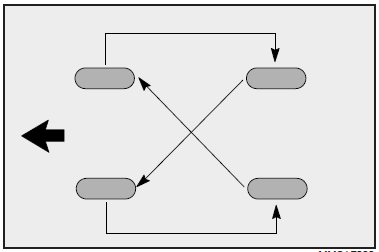 Kia Optima: Tire Rotation
Kia Optima: Tire Rotation
To equalize tread wear, it is recommended that the tires be rotated every 7,500 miles (12000 km) or sooner if irregular wear develops.
During rotation, check the tires for correct balance.
When rotating tires, check for uneven wear and damage. Abnormal wear is usually caused by incorrect tire pressure, improper wheel alignment, out-of-balance wheels, severe braking or severe cornering. Look for bumps or bulges in the tread or side of tire. Replace the tire if you find either of these conditions. Replace tires showing fabric or cord. After rotation, be sure to bring the front and rear tire pressures to specification and check lug nut tightness.

Disc brake pads should be inspected for wear whenever tires are rotated.
✽ NOTICE
Radical tires having asymmetric tread patterns should only be rotated with the tire on the side of the vehicle.
 Inflation Pressures
Inflation Pressures
All tire pressures (including the spare) should be checked monthly when the tires
are cold. ŌĆ£Cold TiresŌĆØ means the vehicle has not been driven for at least three
hours or driven less than one ...
 Tire Replacement
Tire Replacement
If the tire is worn evenly, a tread wear indicator will appear as a solid band
1/2 inch wide (12.7 mm) across the the tread. This shows there is less than 1/16
inch (1.6 mm) of tread left on the t ...
See also:
High beam operation
To turn on the high beam headlights, push the lever away from you. Pull it back
for low beams.
The high beam indicator will light when the headlight high beams are switched
on.
To prevent the ...
Heater & A/C Control Unit(Dual). Components and Components Location
Components
Control Panel
Connector pin function
Connector
PIN NO.
Function
Connector
PIN NO.
Function
...
Yaw-rate and Lateral G Sensor. Repair procedures
Removal
1.
Turn ignition switch OFF and
disconnect the negative (-) battery cable.
2.
Remove the floor console. (Refer
to the Body group - Console)
3.
...
